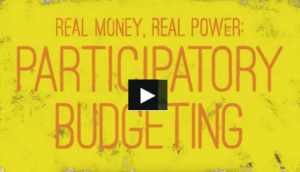. .DEMOCRATIC PARTICIPATION. .
Based on information on the website of the Participatory Budgeting Project
Participatory budgeting (PB) is a different way to manage public money, and to engage people in government. It is a democratic process in which community members directly decide how to spend part of a public budget. The process was first developed in Brazil in 1989, and there are now over 1,500 participatory budgets around the world. Most of these are at the city level, for the municipal budget.

Video: Real money, real power: participatory budgeting
Though each experience is different, most follow a similar basic process: residents brainstorm spending ideas, volunteer budget delegates develop proposals based on these ideas, residents vote on proposals, and the government implements the top projects. For example, if community members identify recreation spaces as a priority, their delegates might develop a proposal for basketball court renovations. The residents would then vote on this and other proposals, and if they approve the basketball court, the city pays to renovate it.
There are so many cities and institutions implementing Participatory Budgeting that it is almost impossible to keep track of them all. However, the Participatory Budgeting Project presents a map showing twenty of the most developed and interesting PB processes in North America, Latin America and Europe that illustrate the diversity of PB models. Readers can click on the markers or view the tables underneath the map to see basic information about each process.
Here are seven of the twenty examples.
Brazil: Porto Alegre, with nearly 1.5 million residents, was the first city to launch a full PB process, in 1989. Since then, up to 50,000 residents have turned out each year to decide how to spend as much as 20% of the city’s annual budget. Participants attend a series of local assemblies, and after months of discussions budget delegates deliver a participatory budget to the city for implementation.
(Article continued in right column)
Participatory budgeting, How does it work?
(Article continued from left column)
Brazil: Belo Horizonte, population 2.5 million, has had a district-level PB since 1993, a Housing PB since 1996, and a digital PB (e-PB) since 2006. Through both local assemblies and online voting, residents allocate over $50 million per year.
Argentina: Rosario’s PB consists of an annual cycle in which over 87,000 city residents decide how to allocate around $9 million of the city budget. In this city of 1 million people, residents discuss spending ideas at neighborhood assemblies, elected delegates develop full budget proposals, and then residents vote on the proposals at another round of voting assemblies. The funds can be spent on both capital projects and services or programs.
USA: In 2009, PBP and Chicago alderman Joe Moore launched the first PB process in the U.S., in the city’s 49th Ward. In the current process, residents of three Wards decide each year how to spend $3 million of taxpayer money.
USA: New York City is host to the largest PB in the U.S. in terms of participants and budget amount. First introduced in 4 council districts in 2011, the annual PBNYC process now spans 24 Council Districts and lets residents directly decided how to spend $25 million in capital discretionary funds.
Canada: Since 2001, Toronto’s public housing authority has engaged tenants in allocating $5 to $9 million of capital funding per year. Tenants identify local infrastructure priorities in building meetings, then budget delegates from each building meet to vote for which priorities receive funding.
Spain: Seville (pop. 700,000) is the largest European city to implement PB. From 2004-2013, residents decided on roughly 50% of local spending for their city districts, for capital projects and programs. They submitted project proposals online or in neighborhood assemblies, and after a series of meetings, locally elected budget delegates delivered the participatory budget to city hall for implementation.
content de lire ce rapport important et le progrès de la culture de la paix.